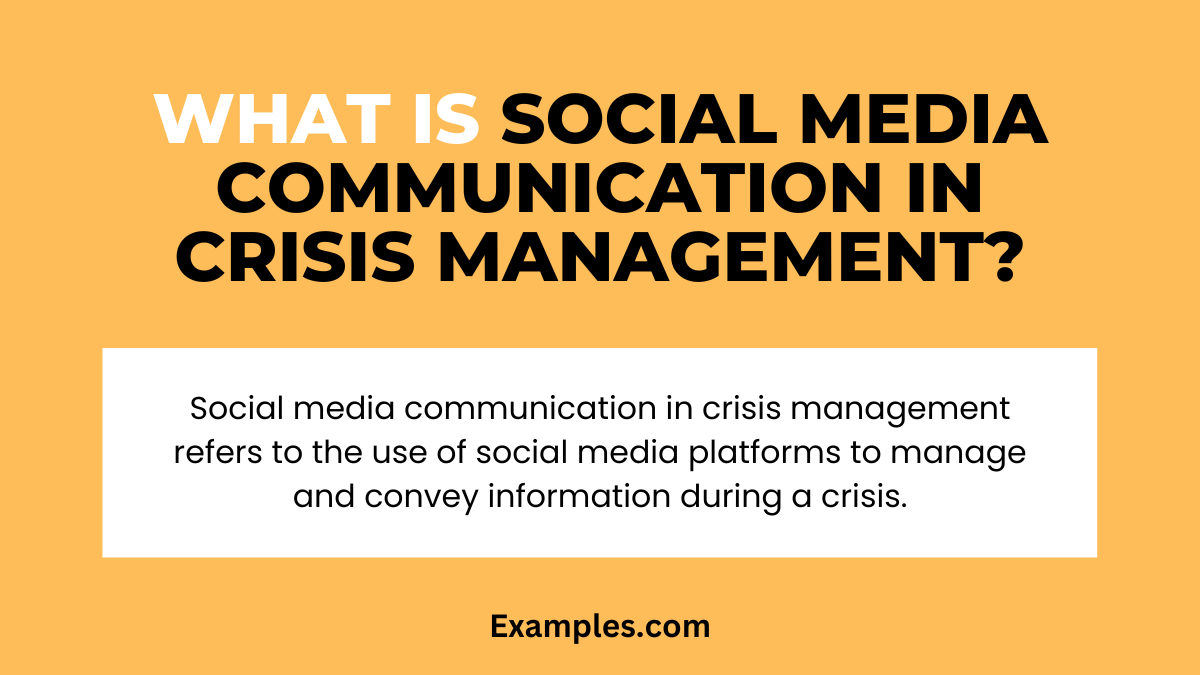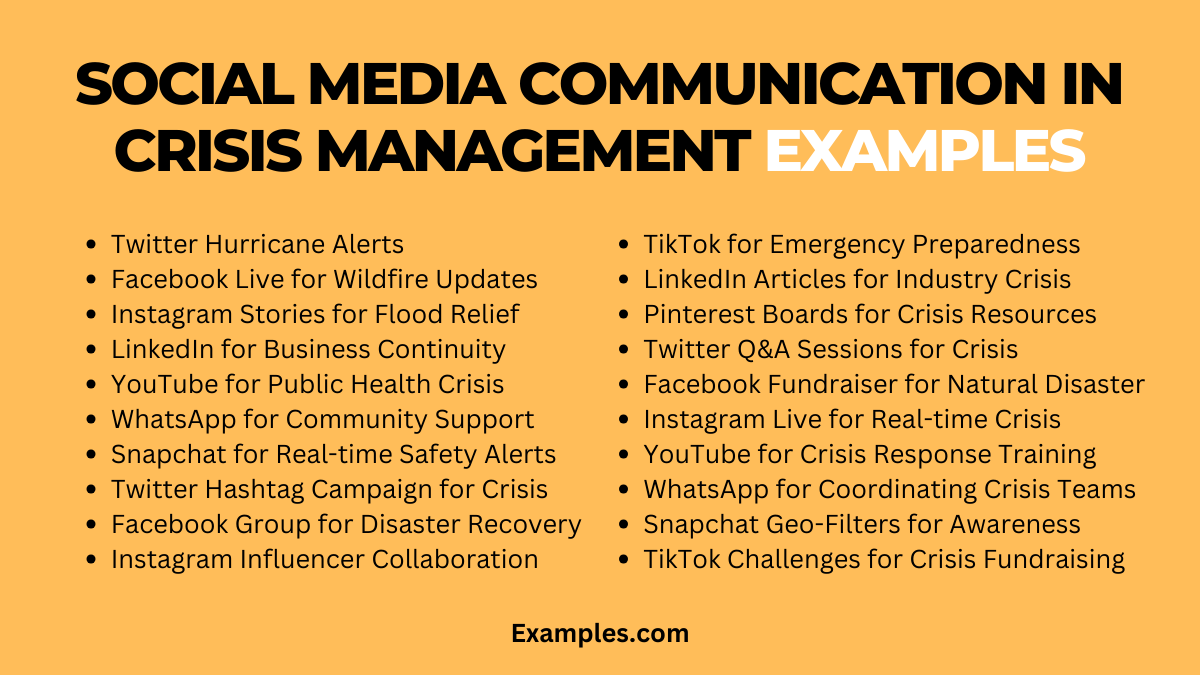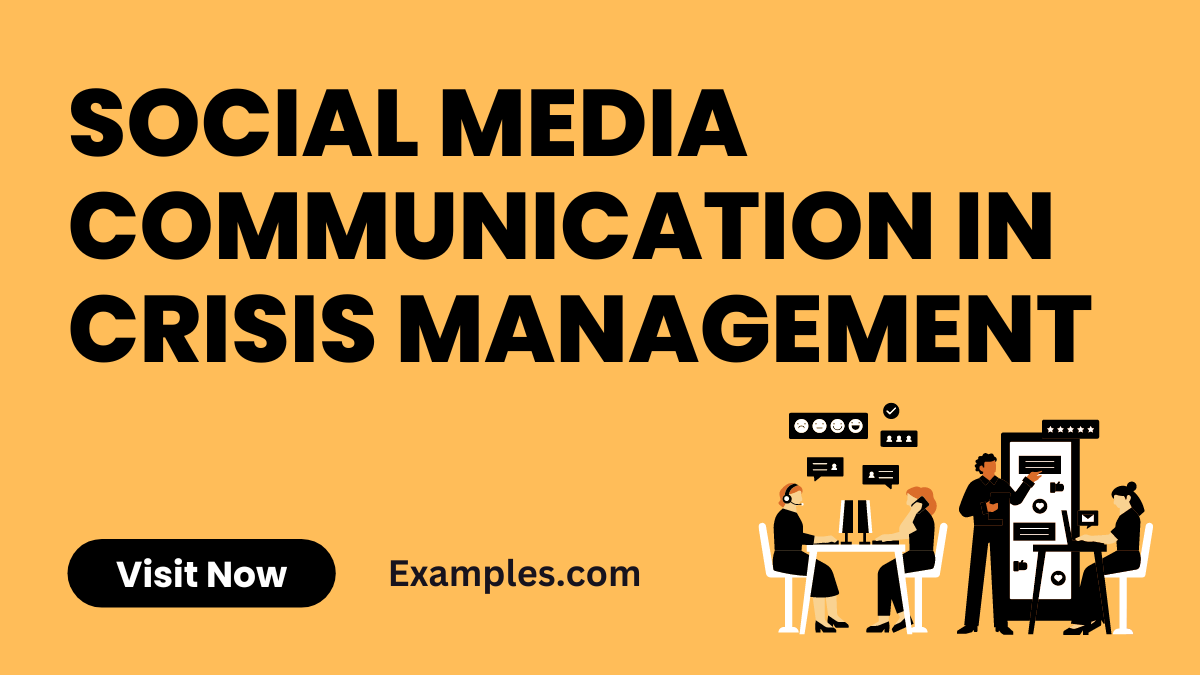19+ Social Media Communication in Crisis Management Examples
In today’s digital era, Social Media Communication plays a crucial role in crisis management. This comprehensive guide delves into how platforms like Twitter, Facebook, and Instagram can be pivotal tools in disseminating timely information, engaging with the public, and managing the narrative during a crisis. Through real-world examples, learn how effective social media strategies can mitigate the impact of crises, maintain public trust, and facilitate recovery. This resource is essential for anyone looking to understand the dynamics of social media in crisis communication scenarios.
What is Social Media Communication in Crisis Management?

Social media communication in crisis management refers to the use of social media platforms to manage and convey information during a crisis. It involves sharing timely updates, responding to concerns, and engaging with the audience to provide accurate information and manage the organization’s reputation. Social media allows for rapid dissemination of information and direct interaction with stakeholders, making it a crucial tool in modern crisis management strategies.
20 Social Media Communication in Crisis Management Examples

Social media is a dynamic tool in crisis management, offering immediate, widespread communication. It’s critical for organizations to effectively use these platforms during crises to provide updates, manage public perception, and offer reassurance. This guide presents 20 unique examples, illustrating diverse strategies and approaches in harnessing social media during crises. Each example is accompanied by a brief explanation, highlighting the key communication techniques and outcomes. These real-world scenarios demonstrate the importance of thoughtful, strategic social media communication in managing emergencies and maintaining public trust.
- Hurricane Alert on Twitter: A weather agency used Twitter to provide real-time updates during a hurricane, including safety instructions and evacuation routes. This proactive approach helped in preparing and protecting the community.
- Facebook Live for Wildfire Updates: A local government utilized Facebook Live to broadcast daily briefings during a wildfire crisis, offering transparent and timely information to residents and media.
- Instagram Stories for Flood Relief: A non-profit organization leveraged Instagram Stories to share on-the-ground relief efforts during a flood, encouraging donations and volunteer sign-ups.
- LinkedIn for Business Continuity: A corporation used LinkedIn to communicate its business continuity plans during a power outage, reassuring stakeholders about minimal disruptions.
- YouTube for Public Health Crisis: Health authorities created educational YouTube videos during a public health crisis, debunking myths and providing factual health advice.
- WhatsApp for Community Support: A community group formed a WhatsApp network to coordinate support and resources for affected families during a local crisis.
- Snapchat for Real-time Safety Alerts: A university employed Snapchat to send instant safety alerts to students during an on-campus emergency.
- Twitter Hashtag Campaign for Crisis Awareness: An NGO initiated a hashtag campaign on Twitter to raise awareness and funds for a humanitarian crisis.
- Facebook Group for Disaster Recovery: Post-disaster, a local community set up a Facebook group to share recovery resources and emotional support.
- Instagram Influencer Collaboration for Crisis Response: A charity collaborated with influencers on Instagram to amplify their crisis response message, reaching a broader audience.
- TikTok for Emergency Preparedness: Government agencies used TikTok to share creative videos on emergency preparedness, engaging a younger demographic.
- LinkedIn Articles for Industry Crisis Management: Industry leaders published articles on LinkedIn discussing crisis management strategies in their sectors.
- Pinterest Boards for Crisis Resources: Organizations created Pinterest boards compiling resources and information for individuals affected by a crisis.
- Twitter Q&A Sessions for Crisis Communication: Companies hosted live Q&A sessions on Twitter to address customer concerns during a product recall crisis.
- Facebook Fundraiser for Natural Disaster Relief: A community started a Facebook fundraiser to aid victims of a natural disaster, raising significant funds.
- Instagram Live for Real-time Crisis Updates: During a transportation strike, a transit company used Instagram Live to give commuters real-time updates.
- YouTube for Crisis Response Training: A safety organization posted training videos on YouTube, educating the public on crisis response techniques.
- WhatsApp for Coordinating Crisis Response Teams: Relief agencies used WhatsApp groups to coordinate teams and resources during a relief operation.
- Snapchat Geo-Filters for Crisis Awareness: During a major environmental crisis, activists used Snapchat geo-filters to spread awareness and encourage action.
- TikTok Challenges for Crisis Fundraising: Charities initiated TikTok challenges to engage the community in fundraising activities during crises.
Why is Social Media Communication Important in Crisis Management?
Social media communication is crucial in crisis management due to its immediate and widespread reach. It allows organizations to rapidly disseminate information, manage public perception, and engage directly with stakeholders. In today’s digital age, social media is often the first point of contact for updates, making it a vital tool for transparency and real-time communication during crises.
Social media communication plays a pivotal role in modern crisis management for several reasons:
- Rapid Information Dissemination: Social media enables organizations to quickly share vital information widely, reaching large audiences in a timely manner.
- Real-Time Engagement: It offers a platform for immediate interaction, allowing organizations to address concerns, answer questions, and clarify misinformation as events unfold.
- Public Perception Management: The way an organization communicates on social media during a crisis significantly influences public perception and sentiment.
- Feedback Loop: Social media serves as a valuable feedback channel, providing instant public reactions that can guide crisis communication strategies.
- Reputation Management: Effective social media use during a crisis can safeguard or enhance an organization’s reputation by demonstrating responsiveness, transparency, and empathy.
What is the Role of Social Media Communication in Crisis Management?
The role of social media in crisis management includes providing timely updates, monitoring public sentiment, and engaging in interactive communication with the audience. It serves as a platform for crisis response, rumor control, and reinforcing official messages. Additionally, social media facilitates community building and support during crises, making it an indispensable communication tool.
The role of social media in crisis management encompasses various aspects:
- Crisis Monitoring: Involves actively watching social media for early signs of crises or escalation. This proactive monitoring helps in quick response and management.
- Public Communication: Utilizes social platforms for disseminating information to the public during crises, ensuring messages reach a wide audience quickly.
- Stakeholder Engagement: Engaging with customers, clients, and other stakeholders through social media. This engagement helps in building trust and providing real-time responses.
- Misinformation Management: Focuses on identifying and correcting false information spreading through social channels. Timely corrections are crucial to prevent panic or confusion.
- Post-Crisis Analysis: Involves analyzing social media interactions and data after a crisis to gain insights. This analysis is key for learning and improving future crisis communication strategies.
How to Develop a Social Media Communication Strategy in Crisis Management?
- Identify Key Platforms: Determine which social media platforms are most used by your target audience. Focus your efforts on these platforms for maximum impact.
- Establish a Response Team: Form a specialized team to handle social media during crises. This team should be trained and prepared to manage online communications effectively.
- Plan for Different Scenarios: Develop specific plans for various types of crises. Tailored responses ensure you are prepared for different situations.
- Create a Content Calendar: Organize a schedule for regular updates and information sharing. This helps in maintaining a consistent presence and ensures timely communication.
- Implement Monitoring Tools: Utilize social media monitoring tools to track mentions of your organization and gauge public sentiment. This can inform your response strategy.
- Develop Clear Messaging: Ensure all communication is clear, accurate, and empathetic. Clear messaging helps in reducing confusion and builds trust with your audience.
How to Use Social Media Communication in Crisis Management?
- Rapid Response: Utilize social media platforms for the swift dissemination of information during a crisis. This timely response is crucial in managing the narrative and maintaining public trust.
- Engage with the Audience: Actively respond to public queries and concerns on social media. This engagement demonstrates attentiveness and a commitment to transparency.
- Monitor Conversations: Regularly monitor online discussions to gauge public perception and to identify any misinformation or rumors.
- Share Accurate Information: Provide factual and up-to-date information to counteract rumors and misinformation. Accurate reporting is essential for maintaining credibility.
- Show Empathy: Communicate with a tone that is understanding and compassionate, acknowledging the concerns and feelings of your audience.
- Post-Crisis Analysis: After the crisis, review your social media performance to identify strengths and areas for improvement. This analysis can inform future crisis communication strategies.
Tips for Successful Social Media Communication in Crisis Management
Tips for successful social media communication in crisis management:
- Quick Response Time: Rapid responses are crucial in social media to maintain control of the narrative. Quick reactions help to set the tone and prevent misinformation.
- Accurate Information: Share only verified information to maintain credibility. Fact-checking is essential to prevent the spread of false information.
- Consistent Updates: Regularly update your audience to keep them informed and engaged. Consistency helps in managing expectations and reducing panic.
- Engage with Audience: Interact with users’ comments and queries to show responsiveness and build trust.
- Monitor Conversations: Keep an eye on what people are saying about the crisis. Monitoring helps in understanding public sentiment and addressing concerns effectively.
- Crisis-Specific Hashtags: Utilize specific hashtags for easy tracking and visibility. Hashtags help in organizing conversations and disseminating information efficiently.
- Post-Crisis Analysis: After the crisis, analyze your social media performance. This analysis is key to understanding the impact of your communication and identifying areas for improvement.
In conclusion, effective social media communication is pivotal in crisis management. It requires a blend of rapid response, accurate information dissemination, and empathetic engagement with audiences. By actively monitoring conversations, providing consistent updates, and tailoring content to various platforms, organizations can effectively manage the narrative during crises. Post-crisis analysis of social media performance is also crucial for continual improvement in crisis communication strategies.



